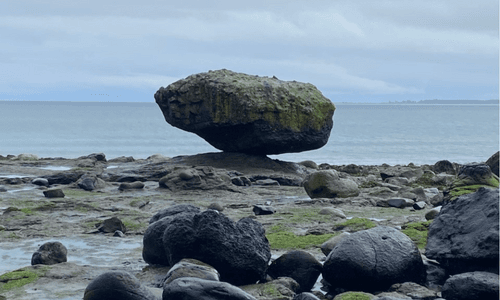ESG Commitments
Annual State of Safety 2022
State of Safety: Our Environmental, Social and Governance Commitments
We aspire to build confidence in a safety system that improves the wellbeing of British Columbians. As a purpose driven organization, our environmental, social, and governance (ESG) reporting provides an overview of our priorities to help improve the safety system by creating a more inclusive, equitable, and sustainable future.
In 2022, we formalized this commitment in our business plan to increase safety outcomes in British Columbia.
Our ESG commitments include:
- Indigenous reconciliation and partnerships
- Climate action
- Equity, diversity, and inclusion
Using elements of the Global Reporting Initiative (GRI) framework, we will regularly monitor, measure, adjust, and report on our efforts to address the most significant risks and opportunities aligned with our vision of Safe technical systems. Everywhere.
Indigenous Reconciliation and Partnerships
In 2022, we furthered our pledge to work together with Indigenous peoples toward technical safety by referencing item 92, Business and Reconciliation, of the Truth and Reconciliation calls to action.

Recognition, Change, and Inclusion
Alongside WorkSafeBC, we collaborated with the Tḱemlúps te Secwépemc people on an Indigenous Nations Safety Initiative. Our incident investigations and operations teams also consulted with Tḱemlúps te Secwépemc on a fatal ammonia incident at an ice making facility that occurred in an industrial park on reserve land in Kamloops.
We engaged with a local artist for a First Nations Cultural Panel to be featured in our Terrace office and sought guidance from the Kitsumkalum and Kitselas Nations to honor a cultural opening ceremony at our office in the spring of 2023.
Partnering with the Climate Action and Sustainability team at the Climate Summit, we supported a proposal for the Pacific Institute for Climate Solutions. This proposal resulted in an awarded grant, allowing us to hire an intern to complete research regarding impacts of climate change events on reserve land. This report will lay the foundation as we explore climate resiliency in partnership with BC’s remote and Indigenous communities.
We recognize that change and inclusion must happen within our organization to further understanding of how we can better share safety information at Indigenous reserves and for Indigenous peoples. This year, our Indigenous Reconciliation and Partnerships team:
- Featured cultural information and education on our internal intranet, like Indigenous Veterans Day and the history and awareness for The Missing & Murdered Indigenous Women & Girls relay (Tears to Hope)
- Reviewed the organization’s Indigenous Relations onboarding education, a mandatory course for new employees
- Welcomed a co-op student with a Master of Public Policy and Global Affairs to the organization
- Sought networking opportunities to further Indigenous recruitment, attending events like the Forward Summit, WorkForce Forward, Inclusity Job Fair, and BC Treaty Commission forum
- Hired an Indigenous consultant to support and guide our external engagement strategy and help with best practices, including decolonizing language in our communications.
- On the National Day for Truth and Reconciliation, we held a lunch and learn to share stories of personal history connecting our employees with their part in the journey towards reconciliation.
Going forward, we will continue expanding our work to deliver on Truth and Reconciliation calls to action:
- Co-op education programs for Indigenous students and a bursary program with the Nicola Valley Institute of Technology (Call to Action #7)
- Embedding Indigenous language into the organization through territorial acknowledgements and the naming of office spaces (Call to Action #13,14)
- Adopted the United Nations Declaration on the Rights of Indigenous Peoples (UNDRIP) as our framework for reconciliation (Call to Action #43)
- Policy changes for historical documents & territorial acknowledgments (Call to Action #47)
- Internal education on anti-discrimination & anti-racism (Call to Action #57)

Climate Action
In 2022, our Climate Action and Sustainability team focused on:
- Preventing safety incidents and hazards related to climate change for the technical systems and equipment that we regulate;
- Enabling the safe adoption of low-carbon technologies;
- Understanding educational and training needs to support climate safety; and
- Reducing energy consumption within the organization.
Preventing Safety Incidents and Hazards Related to Climate Change
We completed the first phase of our climate resiliency program by developing a climate hazard inventory for the following technologies: gas; electrical; boilers, pressure vessels and refrigeration; and elevating devices. The information in this inventory helps us identify technical vulnerabilities and safety hazards that may result when there is a flood, wildfire, heatwave, or other extreme weather event. We launched this work at our Climate Safety Summit, attended by 150 safety partners from across the province, who provided valuable feedback. In November, we shared preliminary findings with 90 clients through two webinar sessions and gathered further insights into the needs of the industry.
Throughout the year, the Incident Investigations team also helped to identify climate events and low-carbon technologies as contributing factors to incidents. We have been tracking safety incidents and hazards related to climate change and analyzing the data to augment the climate hazard inventories.
Enabling the Safe Adoption of Low-Carbon Technologies
Using funding provided by BC Hydro, we researched opportunities to enable the safe adoption of low-carbon technologies. As a result, several priority pilot projects were identified to launch in 2023. These pilots will provide relevant safety information about newer electrical technology, like electric vehicle chargers and energy management systems, and are intended to remove barriers to their adoption, in alignment with BC’s goals. The project started in 2021 and the report was completed in 2022. These efforts contribute to the Provincial Green House Gas Emissions Reduction strategy.
Understanding Educational and Training Needs to Support Climate Change
As our understanding of emerging risks from climate change and low-carbon technologies evolves, we are able to identify training and knowledge gaps for employees and clients. Through our research on low-carbon technologies, we have identified several training opportunities. In addition, we launched an internal Climate Advisory Group for our energy technologies in order to proactively identify emerging knowledge and training gaps. We will work cross-organizationally to implement training throughout 2023.
Reducing Energy Consumption within our Organization
To deliver our safety services, we recognize that travel to sites and offices is unavoidable. We are tracking the greenhouse gas emissions produced by our fleet vehicles and monitoring to reduce energy consumption within our facilities. We have ordered five electric vehicles and 11 hybrid vehicles and plan to implement and scale a low-emission vehicle pilot program once we receive them. Our goal by 2050 is to become net-zero for emissions generated by fleet and facilities. This aligns with BC’s commitment to reach net-zero carbon pollution the same year, through the CleanBC initiative.
Greenhouse gas emissions from fleet and facilities
for our baseline year (2019) and 2022
| 2019 (Baseline) -tCo2e | 2021 -tCo2e | 2022 -tCo2e | |
|---|---|---|---|
| Fleet* | 768 | 393 | 517 |
| Facilities** | 76 | 58 | 62 |
| Total | 844 | 451 | 580 |
| Facilities % Renewable | 79% | 74% | 73% |
| Overall % Renewable | 7% | 10% | 8% |
* Fleet Emissions for 2019 and 2021 updated in 2023 due to usage of revised CO2 fuel emission factor (from 2.200 CO2 kg/L to 2.3073 CO2 kg/L) for 'Light-duty trucks' published in the '2021 B.C. BEST PRACTICES METHODOLOGY FOR QUANTIFYING GREENHOUSE GAS EMISSIONS'
** Facilities Emissions for 2019 and 2021 updated in 2023 due to usage of Revised Emissions Factors, Purchased Electricity (Integrated Grid Factors) published by the BC Government
Equity, Diversity, and Inclusion
Equity, diversity, and inclusion (EDI) are integral parts of our organizational culture. We know that fostering fulsome relationships through these pillars will allow us to remove barriers that limit access to safe decision making. This year, we strived to better understand our clients and our employees.
Externally, we sought to understand the diversity that makes up our client group. We collaborated with researchers at Majid Khoury and Associates to conduct a client segmentation study in March. The study of 2,946 clients set out to learn more about our clients, how they like to connect with us, and what preferences they hold.
We developed a Home Renovation campaign targeting Mandarin speakers, as Mandarin is one of the top five spoken languages in BC. Based on this pilot, we are planning to expand additional public safety campaigns targeted first to Punjabi and Mandarin speakers.
Internally, we supported four active employee resource groups:
- Indigenous Relations and Reconciliation
- Green Initiatives and Sustainability
- Equity, Diversity, and Inclusion
- Mental Health and Wellness
In June we held a Leadership Conference where over 100 leaders participated in learning experiences and training to progress their knowledge, connection, and understanding of EDI and Indigenous Reconciliation. Topics focused on mitigating bias, microaggressions, communication styles, allyship, psychological safety, and employee resiliency. To further align with our environmental, social, and governance framework, the event featured local businesses, vendors, caterers, and speakers.
In July, we were honored to march in the Vancouver PRIDE parade. Technical Safety BC was among 120 parade entries that celebrated diversity, inclusivity, and advocacy for 2SLGBTQAI+ communities.
We also performed our second in-depth inclusion audit of our organization in 2022, asking employees to provide feedback and insight on their experience through an equity, diversity, and inclusion lens. Ninety percent of the questions scored 70% or higher. Additionally, results showed that we have been successful at achieving additional benchmarks to move us on the Global Diversity & Equity Inclusion Benchmarks (GDEIB) scale, advancing from level 2 (reactive) to level 3 (proactive).